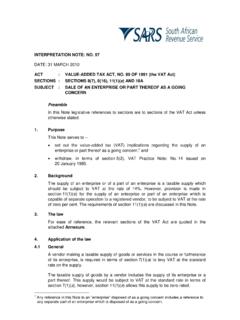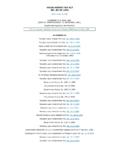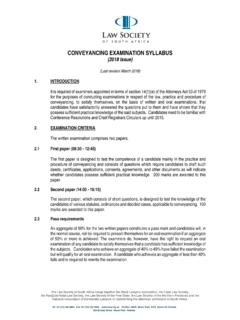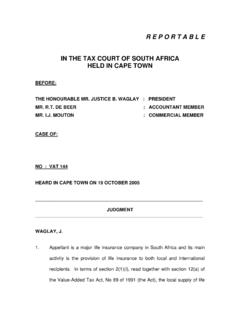Transcription of Value-Added Tax VAT 404
1 VAT 404 Guide for Vendors Value-Added Tax i 10 IMPORTANT PRINCIPLES 1. All prices charged, advertised or quoted by a vendor must include VAT at the applicable rate. (Presently 14% for standard-rated supplies). 2. Vendors are charged with the responsibility of levying VAT and paying it over to the State after deducting permissible VAT inputs and other deductions please make sure that you pay it over on time, otherwise penalties and interest will be charged. 3. VAT charged on supplies made (output tax) less VAT paid to your suppliers (input tax) and other permissible deductions = the amount of VAT payable/refundable. 4. You need a valid tax invoice or a debit note with your VAT number indicated on it as proof of any input tax deductions which you want to make. You must also keep records of all your tax invoices and other records of transactions for at least five years.
2 5. Goods exported to clients in an export country may be charged with VAT at 0%. However, if delivery takes place in RSA, you must charge VAT at 14% to your client, unless the goods are supplied under Part Two of the Export Regulations which allows the zero rate to be applied at the discretion of the supplier when the goods are to be exported via road or rail or are delivered to a harbour or an airport from where the goods will be exported. If your client is a vendor, the VAT charged may be deducted as input tax. If your client is not a vendor, and the goods are subsequently removed from the country, a claim for a refund of the VAT may be made at the offices of the VAT Refund Administrator (the VRA). The VRA is only present at the international airports in the Republic. 6. You may not register for VAT if you only make exempt supplies or if registered, deduct any input tax on goods or services acquired to make exempt supplies, for private use or other non-taxable purposes.
3 Also, as a general rule, input tax may not be deducted where the expense incurred is for the acquisition of a motor car or entertainment, even if used for making taxable supplies. 7. You are required to advise the South African Revenue Service (SARS) within 21 days of any changes in your registered particulars, including any change in your authorised representative, business address, banking details, trading name or if you cease trading. 8. If you have underpaid VAT as a result of a mistake, report it to SARS as soon as possible, rather than leaving it for the SARS auditors to detect. You can make a request for correction on eFiling if registered as a user, otherwise go to your nearest SARS office. 9. You can pay your VAT by using various electronic methods, including eFiling, internet banking, and electronic funds transfer (EFT).
4 You may also pay at certain banks. 10. Report fraudulent activities to SARS by calling the Fraud and Anti-Corruption Hotline on 0800 00 28 70. You may report an incident anonymously if you wish. VAT 404 Guide for Vendors Preface ii PREFACE The VAT 404 is a basic guide where technical and legal terminology has been avoided wherever possible. Although fairly comprehensive, the guide does not deal with all the legal detail associated with VAT and is not intended for legal reference. All references to sections hereinafter are to sections of the Value-Added tax act 89 of 1991 (the VAT Act), unless the context otherwise indicates. The Tax Administration Act 28 of 2011, the Income Tax Act 58 of 1962 and the Customs and Excise Act 91 of 1964 are referred to as the TA Act , Income Tax Act and Customs and Excise Act respectively.
5 The terms Republic , South Africa or the abbreviation RSA , are used interchangeably in this document as a reference to the sovereign territory of the Republic of South Africa, as set out in the definition of Republic in section 1(1). You will also find a number of specific terms used throughout the guide which are defined in the VAT Act and the TA Act listed in Chapter 19 in a simplified form for easy reference. The information in this guide is based on the VAT Act (as amended) and the TA Act (as amended) as at the time of publishing and includes the amendments contained in the Taxation Laws Amendment Act 43 of 2014 and the Tax Administration Laws Amendment Act 44 of 2014 which were promulgated on 20 January 2015 as per GG 38404 and GG 38406, respectively. Below is a brief synopsis of some of the most important changes affecting the administration of VAT since the previous issue of this guide: 1.
6 VAT registration of non-resident suppliers of electronic services The VAT Act was amended in 2014 to provide that non-resident suppliers of certain electronic services must register and account for VAT in South Africa if the value of electronic services supplied has exceeded R50 000 and the supplies are either made to South African residents or payment originates from a South African bank account. The different types of electronic services to which these rules apply are set out in a Regulation. The conditions applicable to the registration of a non-resident supplier of electronic services have now been amended. With effect from 1 April 2015, the non-resident supplier will be liable to register in respect of the supply of electronic services where at least any two of the following three circumstances apply: Electronic services are supplied to South African residents; or Payment for such electronic services originates from a South African bank account; or The recipient has an address ( residential, business or postal) in South Africa, and the total value of taxable supplies of electronic services has exceeded R50 000.
7 Section 11 was also amended with effect from 1 April 2015 to make it clear that electronic services supplied by non-residents may not qualify to be charged with VAT at the zero rate. Refer to Chapter 2 for more details. 2. Voluntary VAT registration The VAT Act was amended by expanding the scope of voluntary registration by allowing persons who meet certain conditions set out in regulations issued under section 23(3)(b) and (d) to apply for voluntary registration. At the time of publishing this guide, the regulations were issued in draft and available on the SARS website. Refer to Chapter 2 for more details. VAT 404 Guide for Vendors Preface iii 3. Definition of second-hand goods The definition of second-hand goods, which already specifically excluded gold coins that are subject to the zero rate, was amended to also exclude gold and goods containing gold.
8 With effect from 1 April 2015 vendors will not be entitled to deduct notional input tax on the acquisition of gold and goods containing gold which was previously owned and used. The compliance issues which the amendment intends to address are the fraudulent issuing of tax invoices and transactions involving illegally mined gold being misrepresented as purchases of second-hand jewellery. This amendment is part of a package of measures introduced by the government to combat illegal mining and the negative effect of such activities on the economy. 4. Customs legislation alignment The VAT Act relies on certain provisions of the Customs and Excise Act with regard to the exportation and importation of goods to ensure that the correct VAT rate or exemption is applied to exports and imports whilst aligning the rules pertaining to the time and value of exports and imports.
9 During 2014 the customs and excise legislative framework was fundamentally restructured by the introduction of the new Customs Control Act, 2014, and the Customs Duty Act, 2014 which are to replace the existing Customs and Excise Act. These new Acts will, however, only come into effect from a future date. As a result of this restructuring, a number of textual amendments had to be made throughout the VAT Act to address alignment issues, including reference to certain new definitions. The VAT amendments come into effect on the same date that the new Customs statutes become effective. Refer to Chapter 12 for more details. 5. Timing of input tax deduction on importation of goods A vendor is allowed an input tax deduction under section 16(3)(a)(iii) and (b)(ii) in respect of the VAT charged on the importation of goods acquired for taxable purposes.
10 The deduction is subject to the vendor or his agent being in possession of a bill of entry or other document prescribed under the Customs and Excise Act relating to the importation as well as the receipt for the payment of the VAT to SARS when making the deduction. In terms of an amendment to section 16(3)(a)(iii) effective 1 April 2014, and section 16(3)(b)(ii), a vendor is only entitled to the deduction of input tax in the tax period in which the VAT is actually paid to SARS. A further amendment to section 16(3)(a)(iii) and (b)(ii) with effect from 1 April 2015, allows a vendor to deduct input tax if the imported goods have been released to the importer or its agent and the vendor is in possession of the relevant documentary proof. Refer to Chapter 12 for more details. 6. Importation of equipment for exploration or production of petroleum Government Notice No.










